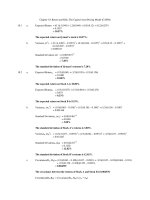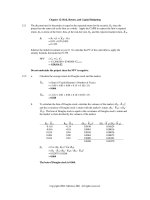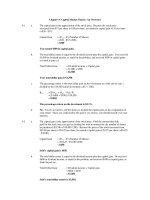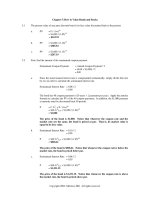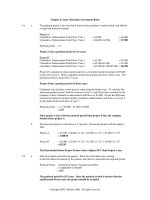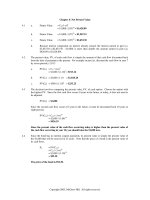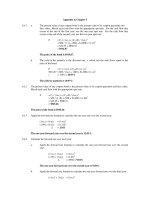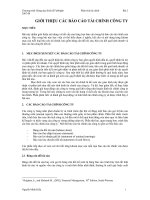Tài liệu Tài chính doanh nghiệp ( Bài tập)_ Chapter 4 pdf
Bạn đang xem bản rút gọn của tài liệu. Xem và tải ngay bản đầy đủ của tài liệu tại đây (185.34 KB, 23 trang )
Chapter 4: Net Present Value
4.1 a. Future Value = C
0
(1+r)
T
= $1,000 (1.05)
10
= $1,628.89
b. Future Value = $1,000 (1.07)
10
= $1,967.15
c. Future Value = $1,000 (1.05)
20
= $2,653.30
d. Because interest compounds on interest already earned, the interest earned in part (c),
$1,653.30 (=$2,653.30 - $1,000) is more than double the amount earned in part (a),
$628.89 (=$1,628.89).
4.2 The present value, PV, of each cash flow is simply the amount of that cash flow discounted back
from the date of payment to the present. For example in part (a), discount the cash flow in year 7
by seven periods, (1.10)
7
.
a. PV(C
7
) = C
7
/ (1+r)
7
= $1,000 / (1.10)
7
= $513.16
b. PV(C
1
) = $2,000 / 1.10 = $1,818.18
c. PV(C
8
) = $500 / (1.10)
8
= $233.25
4.3 The decision involves comparing the present value, PV, of each option. Choose the option with
the highest PV. Since the first cash flow occurs 0 years in the future, or today, it does not need to
be adjusted.
PV(C
0
) = $1,000
Since the second cash flow occurs 10 years in the future, it must be discounted back 10 years at
eight percent.
PV(C
10
) = C
10
/ (1+r)
10
= $2,000 / (1.08)
10
= $926.39
Since the present value of the cash flow occurring today is higher than the present value of
the cash flow occurring in year 10, you should take the $1,000 now.
4.4 Since the bond has no interim coupon payments, its present value is simply the present value of
the $1,000 that will be received in 25 years. Note that the price of a bond is the present value of
its cash flows.
P
0
= PV(C
25
)
= C
25
/ (1+r)
25
= $1,000 / (1.10)
25
= $92.30
The price of the bond is $92.30.
Copyright 2003, McGraw-Hill. All rights reserved.
4.5 The future value, FV, of the firm’s investment must equal the $1.5 million pension liability.
FV = C
0
(1+r)
27
To solve for the initial investment, C
0
, discount the future pension liability ($1,500,000) back 27
years at eight percent, (1.08)
27
.
$1,500,000 / (1.08)
27
= C
0
= $187,780.23
The firm must invest $187,708.23 today to be able to make the $1.5 million payment.
4.6 The decision involves comparing the present value, PV, of each option. Choose the option with
the highest PV.
a. At a discount rate of zero, the future value and present value of a cash flow are always
the same. There is no need to discount the two choices to calculate the PV.
PV(Alternative 1) = $10,000,000
PV(Alternative 2) = $20,000,000
Choose Alternative 2 since its PV, $20,000,000, is greater than that of Alternative 1,
$10,000,000.
b. Discount the cash flows at 10 percent. Discount Alternative 1 back one year and
Alternative 2, five years.
PV(Alternative 1) = C / (1+r)
= $10,000,000 / (1.10)
1
= $9,090,909.10
PV(Alternative 2) = $20,000,000 / (1.10)
5
= $12,418,426.46
Choose Alternative 2 since its PV, $12,418,426.46, is greater than that of Alternative
1, $9,090,909.10.
c. Discount the cash flows at 20 percent. Discount Alternative 1 back one year and
Alternative 2, five years.
PV(Alternative 1) = C / (1+r)
= $10,000,000 / (1.20)
1
= $8,333,333.33
PV(Alternative 2) = $20,000,000 / (1.20)
5
= $8,037,551.44
Choose Alternative 1 since its PV, $8,333,333.33, is greater than that of Alternative
2, $8,037,551.44.
d. You are indifferent when the PVs of the two alternatives are equal.
Alternative 1, discounted at r = Alternative 2, discounted at r
$10,000,000 / (1+r)
1
= $20,000,000 / (1+r)
5
Copyright 2003, McGraw-Hill. All rights reserved.
Solve for the discount rate, r, at which the two alternatives are equally attractive.
[1 / (1+r)
1
] (1+r)
5
= $20,000,000 / $10,000,000
(1+r)
4
= 2
1+r = 1.18921
r = 0.18921 = 18.921%
The two alternatives are equally attractive when discounted at 18.921 percent.
4.7 The decision involves comparing the present value, PV, of each offer. Choose the offer with the
highest PV.
Since the Smiths’ payment occurs immediately, its present value does not need to be adjusted.
PV(Smith) = $115,000
The Joneses’ offer occurs three years from today. Therefore, the payment must be discounted
back three periods at 10 percent.
PV(Jones) = C
3
/ (1+r)
3
= $150,000 / (1.10)
3
= $112,697.22
Since the PV of the Joneses’ offer, $112,697.22, is less than the Smiths’ offer, $115,000, you
should choose the Smiths’ offer.
4.8 a. Since the bond has no interim coupon payments, its present value is simply the present
value of the $1,000 that will be received in 20 years. Note that the price of the bond is
this present value.
P
0
= PV(C
20
)
= C
20
/ (1+r)
20
= $1,000 / (1.08)
20
= $214.55
The current price of the bond is $214.55.
b. To find the bond’s price 10 years from today, find the future value of the current price.
P
10
= FV
10
= C
0
(1+r)
10
= $214.55 (1.08)
10
= $463.20
The bond’s price 10 years from today will be $463.20.
c. To find the bond’s price 15 years from today, find the future value of the current price.
P
15
= FV
15
= C
0
(1+r)
15
= $214.55 (1.08)
15
= $680.59
The bond’s price 15 years from today will be $680.59.
Copyright 2003, McGraw-Hill. All rights reserved.
4.9 Ann Woodhouse would be willing to pay the present value of its resale value.
PV = $5,000,000 / (1.12)
10
= $1,609,866.18
The most she would be willing to pay for the property is $1,609,866.18.
4.10 a. Compare the cost of the investment to the present value of the cash inflows. You should
make the investment only if the present value of the cash inflows is greater than the cost
of the investment. Since the investment occurs today (year 0), it does not need to be
discounted.
PV(Investment) = $900,000
PV(Cash Inflows) = $120,000 / (1.12) + $250,000 / (1.12)
2
+ $800,000 / (1.12)
3
= $875,865.52
Since the PV of the cash inflows, $875,865.52, is less than the cost of the investment,
$900,000, you should not make the investment.
b. The net present value, NPV, is the present value of the cash inflows minus the cost of the
investment.
NPV = PV(Cash Inflows) – Cost of Investment
= $875,865.52 – $900,000
= -$24,134.48
The NPV is -$24,134.48.
c. Calculate the PV of the cash inflows, discounted at 11 percent, minus the cost of the
investment. If the NPV is positive, you should invest. If the NPV is negative, you
should not invest.
NPV = PV(Cash Inflows) – Cost of Investment
= $120,000 / (1.11) + $250,000 / (1.11)
2
+ $800,000 / (1.11)
3
– $900,000
= -$4,033.18
Since the NPV is still negative, -$4,033.18, you should not make the investment.
4.11 Calculate the NPV of the machine. Purchase the machine if it has a positive NPV. Do not
purchase the machine if it has a negative NPV.
Since the initial investment occurs today (year 0), it does not need to be discounted.
PV(Investment) = -$340,000
Discount the annual revenues at 10 percent.
PV(Revenues) = $100,000 / (1.10) + $100,000 / (1.10)
2
+ $100,000 / (1.10)
3
+
$100,000 / (1.10)
4
+ $100,000 / (1.10)
5
= $379,078.68
Since the maintenance costs occur at the beginning of each year, the first payment is not
discounted. Each year thereafter, the maintenance cost is discounted at an annual rate of 10
percent.
Copyright 2003, McGraw-Hill. All rights reserved.
PV(Maintenance) = -$10,000 - $10,000 / (1.10) - $10,000 / (1.10)
2
- $10,000 / (1.10)
3
–
$10,000 / (1.10)
4
= -$41,698.65
NPV = PV(Investment) + PV(Cash Flows) + PV(Maintenance)
= -$340,000 + $379,078.68 - $41,698.65
= -$2,619.97
Since the NPV is negative, -$2,619.97, you should not buy the machine.
To find the NPV of the machine when the relevant discount rate is nine percent, repeat the above
calculations, with a discount rate of nine percent.
PV(Investment) = -$340,000
Discount the annual revenues at nine percent.
PV(Revenues) = $100,000 / (1.09) + $100,000 / (1.09)
2
+ $100,000 / (1.09)
3
+
$100,000 / (1.09)
4
+ $100,000 / (1.09)
5
= $388,965.13
Since the maintenance costs occur at the beginning of each year, the first payment is not
discounted. Each year thereafter, the maintenance cost is discounted at an annual rate of nine
percent.
PV(Maintenance) = -$10,000 - $10,000 / (1.09) - $10,000 / (1.09)
2
- $10,000 / (1.09)
3
–
$10,000 / (1.09)
4
= -$42,397.20
NPV = PV(Investment) + PV(Cash Flows) + PV(Maintenance)
= -$340,000 + $388,965.13 - $42,397.20
= $6,567.93
Since the NPV is positive, $6,567.93, you should buy the machine.
4.12 a. The NPV of the contract is the PV of the item’s revenue minus its cost.
PV(Revenue) = C
5
/ (1+r)
5
= $90,000 / (1.10)
5
= $55,882.92
NPV = PV(Revenue) – Cost
= $55,882.92 - $60,000
= -$4,117.08
The NPV of the item is -$4,117.08.
b. The firm will break even when the item’s NPV is equal to zero.
NPV = PV(Revenues) – Cost
= C
5
/ (1+r)
5
– Cost
$0 = $90,000 / (1+r)
5
- $60,000
r = 0.08447 = 8.447%
The firm will break even on the item with an 8.447 percent discount rate.
Copyright 2003, McGraw-Hill. All rights reserved.
4.13 Compare the PV of your aunt’s offer with your roommate’s offer. Choose the offer with the
highest PV. The PV of your aunt’s offer is the sum of her payment to you and the benefit from
owning the car an additional year.
PV(Aunt) = PV(Trade-In) + PV(Benefit of Ownership)
= $3,000 / (1.12) + $1,000 / (1.12)
= $3,571.43
Since your roommate’s offer occurs today (year 0), it does not need to be discounted.
PV(Roommate) = $3,500
Since the PV of your aunt’s offer, $3,571.43, is higher than your roommate’s offer, $3,500,
you should accept your aunt’s offer.
4.14 The cost of the car 12 years from today will be $80,000. To find the rate of interest such that your
$10,000 investment will pay for the car, set the FV of your investment equal to $80,000.
FV = C
0
(1+r)
12
$80,000 = $10,000 (1+r)
12
Solve for the interest rate, r.
8 = (1+r)
12
0.18921 = r
The interest rate required is 18.921%.
4.15 The deposit at the end of the first year will earn interest for six years, from the end of year 1 to the
end of year 7.
FV = $1,000 (1.12)
6
= $1,973.82
The deposit at the end of the second year will earn interest for five years.
FV = $1,000 (1.12)
5
= $1,762.34
The deposit at the end of the third year will earn interest for four years.
FV = $1,000 (1.12)
4
= $1,573.52
The deposit at the end of the fourth year will earn interest for three years.
FV = $1,000 (1.12)
3
= $1,404.93
Combine the values found above to calculate the total value of the account at the end of the
seventh year:
FV = $1,973.82 + $1,762.34 + $1,573.52 + $1,404.93
= $6,714.61
The value of the account at the end of seven years will be $6,714.61.
Copyright 2003, McGraw-Hill. All rights reserved.
4.16 To find the future value of the investment, convert the stated annual interest rate of eight percent
to the effective annual yield, EAY. The EAY is the appropriate discount rate because it captures
the effect of compounding periods.
a. With annual compounding, the EAY is equal to the stated annual interest rate.
FV = C
0
(1+ EAY)
T
= $1,000 (1.08)
3
= $1,259.71
The future value is $1,259.71.
b. Calculate the effective annual yield (EAY), where m denotes the number of compounding
periods per year.
EAY = [1 + (r/m)]
m
– 1
= [1 + (0.08 / 2)]
2
– 1
= 0.0816
Apply the future value formula, using the EAY for the interest rate.
FV = C
0
[1+EAY]
3
= $1,000 (1 + 0.0816)
3
= $1,265.32
The future value is $1,265.32.
c. Calculate the effective annual yield (EAY), where m denotes the number of compounding
periods per year.
EAY = [1 + (r/m)]
m
– 1
= [1 + (0.08 / 12)]
12
– 1
= 0.083
Apply the future value formula, using the EAY for the interest rate.
FV = C
0
(1+ EAY)
3
= $1,000 (1 + 0.083)
3
= $1,270.24
The future value is $1,270.24.
d. Continuous compounding is the limiting case of compounding. The EAY is calculated as
a function of the constant, e, which is approximately equal to 2.718.
FV = C
0
× e
rT
= $1,000 × e
0.08×3
= $1,271.25
The future value is $1,271.25.
e. The future value of an investment increases as the compounding period shortens because
interest is earned on previously accrued interest payments. The shorter the compounding
period, the more frequently interest is paid, resulting in a larger future value.
Copyright 2003, McGraw-Hill. All rights reserved.
4.17 Continuous compounding is the limiting case of compounding. The future value is a function of
the constant, e, which is approximately equal to 2.718.
a. FV = C
0
× e
rT
= $1,000 × e
0.12×5
= $1,822.12
The future value is $1,822.12.
b. FV = $1,000 × e
0.10×3
= $1,349.86
The future value is $1,349.86.
c. FV = $1,000 × e
0.05×10
= $1,648.72
The future value is $1,648.72.
d. FV = $1,000 × e
0.07×8
= $1,750.67
The future value is $1,750.67.
4.18 Convert the stated annual interest rate to the effective annual yield, EAY. The EAY is the
appropriate discount rate because it captures the effect of compounding periods. Next, discount
the cash flow at the EAY.
EAY = [1+(r / m)]
m
– 1
= [1+(0.10 / 4)]
4
– 1
= 0.10381
Discount the cash flow back 12 periods.
PV(C
12
) = C
12
/ (1+EAY)
12
= $5,000 / (1.10381)
12
= $1,528.36
The problem could also have been solved in a single calculation:
PV(C
12
) = C
T
/ [1+(r / m)]
mT
= $5,000 / [1+(0.10 / 4)]
4×12
= $1,528.36
The PV of the cash flow is $1,528.36.
4.19 Deposit your money in the bank that offers the highest effective annual yield, EAY. The EAY is
the rate of return you will receive after taking into account compounding. Convert each bank’s
stated annual interest rate into an EAY.
EAY(Bank America) = [1+(r / m)]
m
– 1
= [1+(0.041 / 4)]
4
– 1
= 0.0416 = 4.16%
EAY(Bank USA) = [1+(r / m)]
m
– 1
Copyright 2003, McGraw-Hill. All rights reserved.
= [1+(0.0405 / 12)]
12
– 1
= 0.0413 = 4.13%
You should deposit your money in Bank America since it offers a higher EAY (4.16%) than
Bank USA offers (4.13%).
4.20 The price of any bond is the present value of its coupon payments. Since a consol pays the same
coupon every year in perpetuity, apply the perpetuity formula to find the present value.
PV = C
1
/ r
= $120 / 0.15
= $800
The price of the consol is $800.
4.21 a. Apply the perpetuity formula, discounted at 10 percent.
PV = C
1
/ r
= $1,000 / 0.1
= $10,000
The PV is $10,000.
b. Remember that the perpetuity formula yields the present value of a stream of cash flows
one period before the initial payment. Therefore, applying the perpetuity formula to a
stream of cash flows that begins two years from today will generate the present value of
that perpetuity as of the end of year 1. Next, discount the PV as of the end of 1 year back
one year, yielding the value today, year 0.
PV = [C
2
/ r] / (1+r)
= [$500 / 0.1] / (1.1)
= $4,545.45
The PV is $4,545.45.
c. Applying the perpetuity formula to a stream of cash flows that begins three years from
today will generate the present value of that perpetuity as of the end of year 2. Thus, use
the perpetuity formula to find the PV as of the end of year 2. Next, discount that value
back two years to find the value today, year 0.
PV = [C
3
/ r] / (1+r)
2
= [$2,420 / 0.1] / (1.1)
2
= $20,000
The PV is $20,000.
4.22 Applying the perpetuity formula to a stream of cash flows that starts at the end of year 9 will
generate the present value of that perpetuity as of the end of year 8.
PV
8
= [C
9
/ r]
= [$120 / 0.1]
= $1,200
To find the PV of the cash flows as of the end of year 5, discount the PV of the perpetuity as of the
end of year 8 back three years.
Copyright 2003, McGraw-Hill. All rights reserved.
